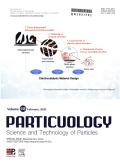- 钛学术文献服务平台 \
- 学术期刊 \
- 工业技术期刊 \
- 化学工业期刊 \
- 颗粒学报(英文版)期刊 \
A leakage particle-wall impingement based vibro-acoustic characterization of the leaked sand-gas pipe flow
A leakage particle-wall impingement based vibro-acoustic characterization of the leaked sand-gas pipe flow
基本信息来源于合作网站,原文需代理用户跳转至来源网站获取
摘要:
Solid particle leakage detection in double-wall pipes is industrially important,especially in chemical and petroleum engineering.Here,we developed vibration and acoustic sensor approaches for the character-ization and comparative study of the applicability of leakage sand particle detection from the flow of gas pipes.A specific wideband vibration sensor and pressure-field microphone were selected to identify the vibro-acoustic characteristics within 50 kHz of the particle leakage.The vibro-acoustic time-behaviours and characteristic frequencies of particle leakage were observed by the time-frequency method.The leakage gas flow noise was verified by coherence analysis and minimized by a digital bandpass and band-elimination filter.Corresponding experiments were performed,and good agreement was found between the release pressures(0.1-0.3MPa)with different leak sizes(0-8 mm)under different sand masses(120 lm)and vibro-acoustic Root-Mean-Square(RMS)levels.In the comparison of the two meth-ods,the vibration method has a better frequency response for the leakage flow and is good for identifying whether there are particle leaks.The acoustic method has a time behaviour response and is good for establishing the relationship between the particle mass and signals.In addition,the acoustic method has frequency shift features with a better signal to noise ratio.The acoustic method lays the foundation for future work of more complex leakage detection combining the advantages of vibration and the acoustic method.

推荐文章
Carbazoles and benzocarbazoles confirm migration of leaked petroleum through caprocks and overlaying
Migration
Geochromatography
Leakage
North Sea
Valhall
SAND-Ⅱ解谱的不确定度分析
不确定度
SAND-Ⅱ
蒙特卡罗方法
随机样本:标准偏差
PIPE ROCK钻柱扭摆系统应用评价
页岩气
钻柱扭摆系统
钻柱托压
定向工具
PIPE ROCK
水平井
纯钻时效
内容分析
关键词云
关键词热度
相关文献总数
(/次)
(/年)
引文网络
引文网络
二级参考文献 (16)
共引文献 (5)
参考文献 (32)
节点文献
引证文献 (0)
同被引文献 (0)
二级引证文献 (0)
1994(1)
- 参考文献(0)
- 二级参考文献(1)
1999(1)
- 参考文献(0)
- 二级参考文献(1)
2000(1)
- 参考文献(0)
- 二级参考文献(1)
2001(2)
- 参考文献(0)
- 二级参考文献(2)
2003(1)
- 参考文献(1)
- 二级参考文献(0)
2005(3)
- 参考文献(0)
- 二级参考文献(3)
2006(3)
- 参考文献(1)
- 二级参考文献(2)
2007(3)
- 参考文献(1)
- 二级参考文献(2)
2008(2)
- 参考文献(1)
- 二级参考文献(1)
2009(2)
- 参考文献(0)
- 二级参考文献(2)
2012(3)
- 参考文献(2)
- 二级参考文献(1)
2013(1)
- 参考文献(1)
- 二级参考文献(0)
2014(1)
- 参考文献(1)
- 二级参考文献(0)
2015(1)
- 参考文献(1)
- 二级参考文献(0)
2016(3)
- 参考文献(3)
- 二级参考文献(0)
2017(3)
- 参考文献(3)
- 二级参考文献(0)
2018(7)
- 参考文献(7)
- 二级参考文献(0)
2019(9)
- 参考文献(9)
- 二级参考文献(0)
2020(1)
- 参考文献(1)
- 二级参考文献(0)
2021(0)
- 参考文献(0)
- 二级参考文献(0)
- 引证文献(0)
- 二级引证文献(0)
引文网络交叉学科
相关学者/机构
期刊影响力
颗粒学报(英文版)
主办单位:
中国颗粒学会
中国科学院过程工程研究所
出版周期:
双月刊
ISSN:
1674-2001
CN:
11-5671/O3
开本:
大16开
出版地:
北京中关村北二条1号中科院过程所内
邮发代号:
创刊时间:
2003
语种:
eng
出版文献量(篇)
1742
总下载数(次)
0
总被引数(次)
8327
期刊文献
相关文献
推荐文献
- 期刊分类
- 期刊(年)
- 期刊(期)
- 期刊推荐
一般工业技术
交通运输
军事科技
冶金工业
动力工程
化学工业
原子能技术
大学学报
建筑科学
无线电电子学与电信技术
机械与仪表工业
水利工程
环境科学与安全科学
电工技术
石油与天然气工业
矿业工程
自动化技术与计算机技术
航空航天
轻工业与手工业
金属学与金属工艺
颗粒学报(英文版)2022
颗粒学报(英文版)2021
颗粒学报(英文版)2020
颗粒学报(英文版)2019
颗粒学报(英文版)2018
颗粒学报(英文版)2017
颗粒学报(英文版)2016
颗粒学报(英文版)2015
颗粒学报(英文版)2014
颗粒学报(英文版)2013
颗粒学报(英文版)2012
颗粒学报(英文版)2011
颗粒学报(英文版)2010
颗粒学报(英文版)2009
颗粒学报(英文版)2008
颗粒学报(英文版)2007
颗粒学报(英文版)2006
颗粒学报(英文版)2005
颗粒学报(英文版)2004
颗粒学报(英文版)2003

 免费查重
免费查重










